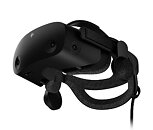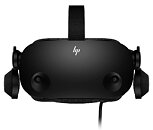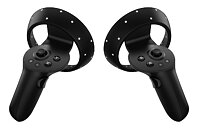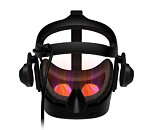- Joined
- Oct 9, 2007
- Messages
- 47,853 (7.38/day)
- Location
- Dublin, Ireland
| System Name | RBMK-1000 |
|---|---|
| Processor | AMD Ryzen 7 5700G |
| Motherboard | Gigabyte B550 AORUS Elite V2 |
| Cooling | DeepCool Gammax L240 V2 |
| Memory | 2x 16GB DDR4-3200 |
| Video Card(s) | Galax RTX 4070 Ti EX |
| Storage | Samsung 990 1TB |
| Display(s) | BenQ 1440p 60 Hz 27-inch |
| Case | Corsair Carbide 100R |
| Audio Device(s) | ASUS SupremeFX S1220A |
| Power Supply | Cooler Master MWE Gold 650W |
| Mouse | ASUS ROG Strix Impact |
| Keyboard | Gamdias Hermes E2 |
| Software | Windows 11 Pro |
Today, HP Inc. unveiled its latest virtual reality (VR) headset, the HP Reverb G2, in collaboration with industry leaders Valve and Microsoft. The HP Reverb G2 is the world's highest resolution VR headset among major vendorsi, delivering cutting-edge optics, inside-out tracking, spatial 3D audio, natural gestures, long-wearing comfort, and plug and play support for Windows Mixed Reality and SteamVR.
"The power of collaboration is on full display with the HP Reverb G2, and alongside Valve and Microsoft, we engineered a no-compromises VR headset that's immersive, comfortable, and compatible across Windows Mixed Reality and SteamVR," said Spike Huang, vice president and global lead of VR, HP Inc. "The time is now for VR and the HP Reverb G2 brings high-quality VR to the masses with more immersion for gamers, interactive experiences for creators, increased engagement for collaboration, and higher retention rates for education and training."




Developing a New, Better VR Experience
The VR landscape is changing, and how people interact with technology, and each other, is evolving. This past April, SteamVR saw nearly one million additional monthly-connected headsets, tripling the previous largest monthly gain, and by 2021, 25-30% of the workforce will be working-from-home multiple days a weekii and searching for new ways to collaborate. Technology must evolve to meet the changing needs of the customer with flexibility across a variety of industries and platforms.
HP worked closely with Valve and Microsoft to bring customers cutting-edge viewing, audio, and gesture technology, along with seamless integration across Windows Mixed Reality and SteamVR platforms. Keeping all of the best elements from the HP Reverb G1, including the industry's highest-resolution LCDs in a lightweight design, and by incorporating new aspects throughout - 114-degree field of view for a more immersive experience, better audio with new speakers that enable spatial audio, 4-camera tracking enables 2X the controller tracking volume, and increased comfort for extended VR sessions - this no-compromise VR headset is built for gaming, creation, collaboration, and learning.
"The HP Reverb G2 is an exciting device that takes advantage of the inside-out tracking technology in Windows Mixed Reality for full six degrees-of-freedom movement and spatial audio," said Mark Bolas, partner director of incubation at Microsoft. "With four cameras, the controller tracking feels even more like an extension of your hands, making the sense of immersion that much stronger."
"We're happy to see the expansion of the VR ecosystem in a way that is great for high-fidelity gaming," said Jeremy Selan, VR Engineer at Valve. "Providing customers with another quality option that includes some of Valve's technology is good news for the VR community and we are happy to support that."
Reverb G2 Key Features:
The HP Reverb VR Headset G2 is scheduled for availability starting Fall 2020 for $599 (U.S.).
US pre-orders will be available May 28, 2020 via HP.com, SteamVR homepage, and select channel partners and pre-orders for select countries will be available over the next few weeks and months.
For more information, visit the product page.
View at TechPowerUp Main Site
"The power of collaboration is on full display with the HP Reverb G2, and alongside Valve and Microsoft, we engineered a no-compromises VR headset that's immersive, comfortable, and compatible across Windows Mixed Reality and SteamVR," said Spike Huang, vice president and global lead of VR, HP Inc. "The time is now for VR and the HP Reverb G2 brings high-quality VR to the masses with more immersion for gamers, interactive experiences for creators, increased engagement for collaboration, and higher retention rates for education and training."




Developing a New, Better VR Experience
The VR landscape is changing, and how people interact with technology, and each other, is evolving. This past April, SteamVR saw nearly one million additional monthly-connected headsets, tripling the previous largest monthly gain, and by 2021, 25-30% of the workforce will be working-from-home multiple days a weekii and searching for new ways to collaborate. Technology must evolve to meet the changing needs of the customer with flexibility across a variety of industries and platforms.
HP worked closely with Valve and Microsoft to bring customers cutting-edge viewing, audio, and gesture technology, along with seamless integration across Windows Mixed Reality and SteamVR platforms. Keeping all of the best elements from the HP Reverb G1, including the industry's highest-resolution LCDs in a lightweight design, and by incorporating new aspects throughout - 114-degree field of view for a more immersive experience, better audio with new speakers that enable spatial audio, 4-camera tracking enables 2X the controller tracking volume, and increased comfort for extended VR sessions - this no-compromise VR headset is built for gaming, creation, collaboration, and learning.
"The HP Reverb G2 is an exciting device that takes advantage of the inside-out tracking technology in Windows Mixed Reality for full six degrees-of-freedom movement and spatial audio," said Mark Bolas, partner director of incubation at Microsoft. "With four cameras, the controller tracking feels even more like an extension of your hands, making the sense of immersion that much stronger."
"We're happy to see the expansion of the VR ecosystem in a way that is great for high-fidelity gaming," said Jeremy Selan, VR Engineer at Valve. "Providing customers with another quality option that includes some of Valve's technology is good news for the VR community and we are happy to support that."
Reverb G2 Key Features:
- Immersive Viewing: The new Valve designed lenses provide a fantastic boost in the visual experience with optics and reduced mural full RGB stripe, delivering 2K by 2K per eye. Users will be able to see text and textures more clearly, providing a better experience and increased retention. Plus, the 114-degree field of view adds to the immersive experience.
- Hear in 3D with Spatial Audio: The new speakers sit 10 mm off the ear, allowing for enhanced comfort during set-up or removal. Plus, the new audio solution is spatial audio ready, allowing the user to experience a true sense of 3D space when immersed in VR worlds, with support for Microsoft spatial audio, and HP Labs new spatial audio format that is anchored in artificial intelligence, new signal processing, and psychoacoustics.
- Natural Gestures: The controllers come with new intuitive control features including an optimized button layout, superb application and game compatibility, and the ability to be pre-paired via Bluetooth for easy out-of-the-box set-up. The 4-camera Window Mixed Reality headset also enables 2X the controller tracking volume, maintaining six degrees of freedom without external sensors or lighthouses.
- Long-Wearing Comfort: The HP Reverb VR Headset G2 is more comfortable than the previous generation with an increased facemask cushion for better weight distribution for extended VR sessions and optional replaceable face gaskets for ease of cleaning between sessions. Users can easily flip the facemask 90 degrees when moving back and forth from the virtual to the real world.
- Everything Feels Fluid: The HP Reverb VR Headset G2 includes Windows Mixed Reality support for a plug and play experience with the latest Windows Builds, allowing for a quick and painless set-up and SteamVR compatibility for access to the community's favorite games and applications.
The HP Reverb VR Headset G2 is scheduled for availability starting Fall 2020 for $599 (U.S.).
US pre-orders will be available May 28, 2020 via HP.com, SteamVR homepage, and select channel partners and pre-orders for select countries will be available over the next few weeks and months.
For more information, visit the product page.
View at TechPowerUp Main Site




